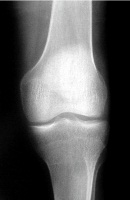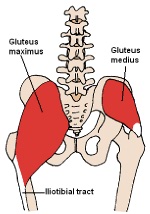Soccer Training Tip: Does your knee hurt? Address the knee or somewhere else?
The goal of soccer training is improved performance, injury prevention, soccer skills and tactics. Improved performance should never come at the cost of an injured player. Goal #1 is injury prevention in a soccer conditioning program. Goal #2 is to improve performance.
If you are suffering from a case of knee pain is the problem really your knee or something else? When that nagging knee pain flairs up again and again will addressing the knee or some other part of the body fix the problem?
To answer that question I would first have to say what is the knee problem. Let's say that it is something like tendonitis of the knee. Trying to address tendonitis of the knee with only medications and rest is like trying to fix the overweight, overeating person with only liposuction. The liposuction may provide temporary results but unless the overeating and lack of exercise is addressed they will put it back on. Just like you don't tackle weight loss directly at the fat. You don't always attack the knee pain directly at the knee. Otherwise the knee pain will continue to come back. .

So how do other parts of the body affect the knee?
The body has multiple parts working together at any one time to help achieve the purpose it is striving for at that moment. Forces are transferred up and down the body through the feet up through the legs and back. In movement if certain parts are dysfunctional then energy leaks out thus causing less than optimal movement and potentially causing injury because of overcompensation in other parts of the body.
Let me give you an analogy. If we tied a rope around your waist and stood 4 feet away and pulled on the rope what would cause the pulling. It is me standing 4 feet away pulling on the rope which is connected to your waist. It is not the waist causing the discomfort. The same is with the knee. Muscles and bones connect the body together. They transmit forces down and through the body.
What specifically can I work on if I have knee pain?
First of all, Always consult with a medical professional. This article is for educational purposes and is not meant to take the place of professional medical advice.
If you have certain types of knee pain like tendonitis you should examine the Gluteus Medius. The Gluteus Medius deals specifically with the stability of leg. A weak or non active Gluteus Medius can cause instability of the leg which can potentially cause knees problems like tendonitis.
As Mike Boyle says in Designing Strength Training Programs and Facilities, In many athletes the muscles that control the hip are either too weak to perform their function or are not "turned on" neurologically. As a result, the support structures of the knee are forced to provide stability instead of the gluteus Medius. This may mean pain in the IT band, patellar tendon, or under the kneecap.
Where is the gluteus Medius?

Image from: Wikimedia Commons
What exercises can you do to strengthen the Gluteus Medius?
Strengthen the Glutes
Band walks are a great way to strengthen the Glute Medius. To do band walks put a band around the ankles and bend your knees slightly. As you walk laterally make sure to not let your feet come together. Start with about 1 to 1.5 feet in between your two feet. Then walk laterally taking steps of only about 6 inches. Keep your shoulders above the hips and walk tall. Don't slouch over. Your appearance should be as if you are gliding across the floor. Once you walk one direction then immediately walk laterally the other way. The primary motion to focus on is the abduction of the hips. (Mike Boyle Designing Strength Training Programs and Facilities)
Turn on the Glutes
To turn on the Gluteus Medius Mike Boyle is his book Designing Strength Training Programs and Facilities says, "bands below the knee joint can be used in double leg squatting and in some single leg squat variations."
This just means putting a band just below and around both knee caps so that pressure is pulling both knees together. This causes the Gluteus Medius to operate to keep the knees from coming together.
